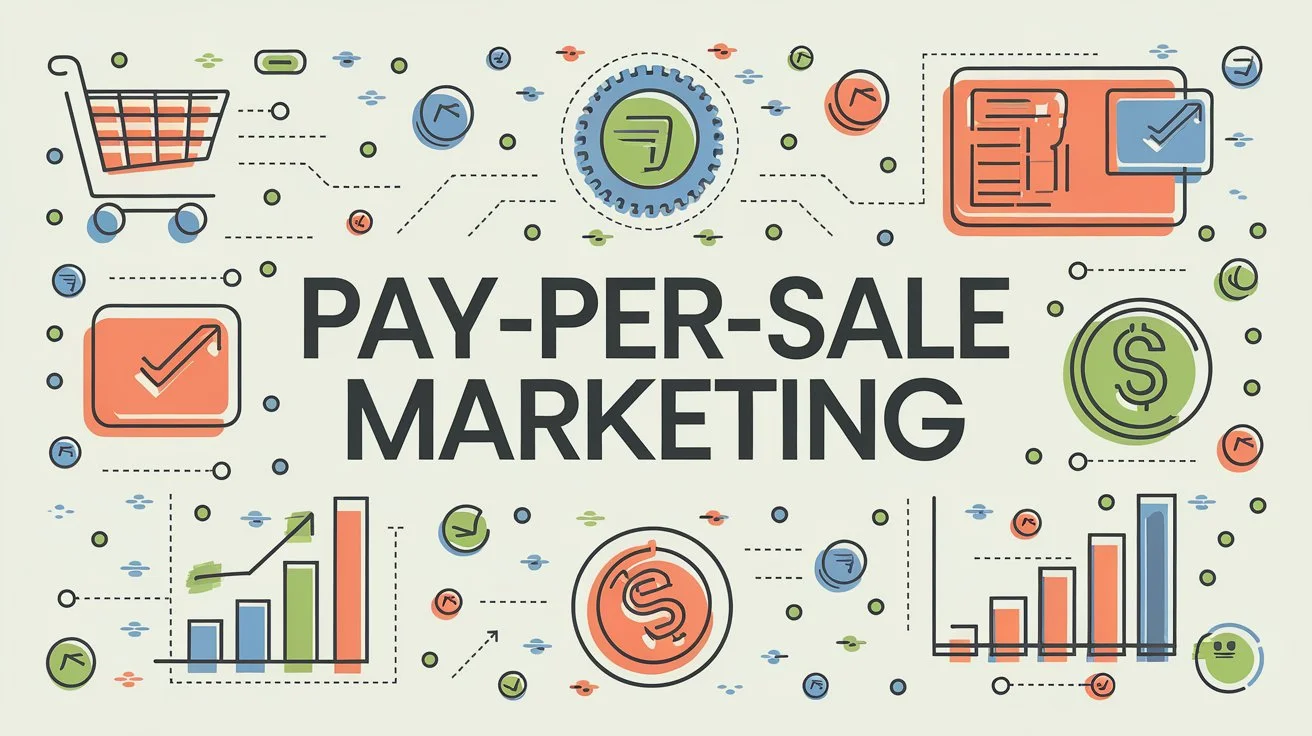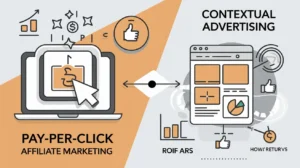Pay per Sale affiliate marketing is a brilliant way to rake in some extra dough if you have a knack for promoting products online. Let’s talk about two juicy flavors of affiliate marketing: Pay-Per-Sale (PPS) and Pay-Per-Lead (PPL). Both have their own charms and quirks.
Pay-Per-Sale Affiliate Marketing

Pay-Per-Sale, or cost-per-sale if you want to get fancy, rewards you with a slice of the pie every time someone buys through your link. The more you sell, the more you earn—simple as that. No sales? No cash. This is the classic model, making it the bread and butter of affiliate marketing.
In this scenario, your paycheck hinges on how good you are at turning browsers into buyers. Cha-ching when there’s a sale, zilch when there isn’t (GrowAnn).
Why Pay-Per-Sale Rocks
- Cha-Ching Commission: These programs usually pay better than other types.
- Show Me the Money: Your income reflects your hustle.
- Safe Bet for Merchants: Merchants love it ’cause they only pay when you bring in the bacon.
Pay-Per-Lead Affiliate Marketing
Now, let’s flip the coin to Pay-Per-Lead. Here, you get paid for sending potential customers their way, whether they buy or not. Generating leads is the name of the game, perfect for businesses keen on growing their contacts or grooming future buyers (Xperiencify).
Here, you’re paid based on how many people show interest, not on how many whip out their credit cards.
The Skinny on Pay-Per-Lead
| Feature | Pay-Per-Sale | Pay-Per-Lead |
|---|---|---|
| How You Earn | By selling stuff | By generating interest (leads) |
| Risk for You | No sales, no pay | Paid even without sales |
| Focus | Sell, sell, sell | Get those leads |
| Best For | Hard-hitting sales campaigns | Businesses aiming to collect leads |
Beyond these, the affiliate world is your oyster. You can dive into Pay-Per-Click or other funky models. For other paths you could wander down, check out our article on types of affiliate marketing intro.
Whichever path you choose, just remember: mastering any form of affiliate marketing comes down to knowing your audience and always giving them a reason to click that link! Happy earning!
Alright, let’s break down Pay-Per-Sale (PPS) affiliate marketing. It’s a way for folks to earn by getting people to buy stuff from merchants. We’ll cover how the money works, the perks, and how the moolah lands in your pocket.
How the Commission Cake is Divided
Here’s the scoop: With PPS, you get a slice of the sales pie. The bigger the sale, the bigger your slice. Simple, right? If you’re good at convincing folks to click ‘buy’, you get rewarded.
What’s sweet about it:
- Shared Goals: When you make a sale, cha-ching! It’s a win-win. Your hustle equals direct dollars.
- Big Bucks Potential: The more sales you rack up, the fatter your wallet gets.
- Buddies with Benefits: Hooking up with merchants for the long haul means steady cash flow.
| What’s What | Deets |
|---|---|
| Type of Payment | Your cut from each sale |
| When You Get Paid | Once the sale’s a done deal |
| Who’s It For | High-ticket item hustlers |
Wanna dive deeper into different affiliate gigs? Check out our intro to affiliate marketing.
How You Get Paid
It’s pretty chill. A customer buys through your link, the system tracks it, then it’s up to the merchants to clear the sale. You get paid once they’re sure no returns or chargebacks are coming your way.
Here’s the play-by-play:
- Sale Seal: The merchant confirms the sale.
- Number Crunching: Your cut is calculated based on the deal.
- Cash in Hand: Merchants usually pay up monthly or every couple of months. Some might need you to reach a certain amount before they release your cash.
| Payment Part | What You Need to Know |
|---|---|
| How Often | Monthly or Bi-monthly |
| Minimum Dough | Changes with each merchant |
| How You Get Paid | Bank transfer, PayPal, etc. |
This process helps keep things fair for everyone. Curious about other models? Peek at our articles on pay per click affiliate marketing and pay per lead affiliate marketing for the full picture.
Get to know these nooks and crannies, and you’ll be navigating the affiliate scene like a pro.
If you’re diving into the wild and often thrilling ride that is affiliate marketing, knowing your metrics is your map and compass. These numbers don’t just help you keep score; they’re the key to making smart moves, boosting profits, and figuring out what actually works in your campaigns. To win big, you’ve gotta let data rule your decisions.
Must-Know Numbers
Let’s break down the essential stats you’ll need to keep an eye on. If you’re playing the pay-per-sale game, these are your go-tos:
| Metric | What It Means |
|---|---|
| Commission Rate | The chunk of the sale you pocket for every successful transaction. |
| Average Commission (AVC) | What you typically earn per sale, calculated over a set period. |
| Earnings Per Click (EPC) | How much dough you make per click on your affiliate link. |
| Average Payout Time | How long it usually takes for you to get paid after a sale. |
| Void Rate | The number of sales that fall through or get canceled—ouch. |
| Clicks | The click count on your affiliate links. |
| Conversion Rate | The percentage of those clicks that turn into actual sales. |
| Average Order Value (AOV) | How much people are spending, on average, per order through your links. |
| Number of Conversions | The total tally of sales through your affiliate hustling. |
These metrics aren’t just for your benefit. Advertisers want to see the performance too. Everyone’s looking to see what’s working (Commission Factory).
Tweak and Tune for Peak Performance
Keep your eyes peeled on your metrics to fine-tune your strategy. Regularly checking things out helps you spot problem areas, like high cancellation rates, so you can adjust your approach. This data-driven hustle means you’re pushing products to the right crowd and getting the most out of every effort (Post Affiliate Pro).
Focused metrics like revenue are what pay-per-sale affiliate marketing is all about. Regular analysis lets you optimize for maximum cash flow (Post Affiliate Pro).
If different affiliate marketing styles catch your eye—like pay-per-click or pay-per-lead—getting cozy with these metrics will still pay off across the board.
Affiliate marketing is always changing, offering fresh trends and chances for everyone, no matter how experienced you are. Let’s break it down.
Changing Game
Tech keeps shaking things up. With digital marketing on the rise, tactics are shifting. Now, brands are teaming up with influencers, using social media to spread the word. These partnerships don’t just boost brand visibility—they open doors for affiliate marketers to earn through endorsements.
Ever heard of high-ticket affiliate marketing? It’s booming. The global scene could hit $27.78 billion by 2027 (Phonexa). Affiliates can snag bigger commissions by diving into pricier niches. And don’t forget mobile commerce. More folks are shopping on their phones, so make sure your affiliate sites are mobile-friendly.
Growth and Staying Power
Affiliate marketing’s got a bright future. It’s a solid gig for both newbies and seasoned pros. The big draw? Earning passive income—making money even when you’re not hustling. Tools like Xperiencify help track metrics and boost campaign performance.
Key metrics are your best friends. If you’re into pay per sale affiliate marketing, keep an eye on these:
| Key Metrics | Why They Matter |
|---|---|
| Commission Rate | Shows earnings per sale |
| Average Commission | Gauges profitability |
| Earnings Per Click | Tracks traffic effectiveness |
| Average Payout Time | Ensures timely payments |
| Void Rate | Tracks unsuccessful sales |
Get familiar with clicks, conversion rates, average order values (AOV), and conversion numbers. These figures help affiliates and advertisers shape strategies. Making data-driven decisions is key to raking in revenue and keeping your campaigns on point (Commission Factory).
No matter how the field evolves, sticking to solid metrics and adapting to new technology keeps affiliate marketing a goldmine for digital savvy folks.
What is the difference between Pay-Per-Sale and Pay-Per-Lead?
Pay-Per-Sale (PPS): You earn a commission for each sale made through your referral link.
Pay-Per-Lead (PPL): You get paid for generating leads, such as sign-ups or form completions, regardless of whether a sale is made.
What metrics should I track as an affiliate marketer?
Key metrics include commission rate, earnings per click (EPC), conversion rate, average order value (AOV), and click-through rate (CTR).
How do I get paid in affiliate marketing?
Payments are typically made through bank transfers, PayPal, or other methods specified by the affiliate program, usually on a monthly or bi-monthly basis once a minimum payout threshold is met.











